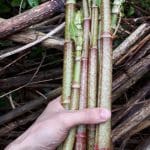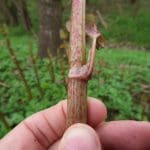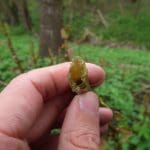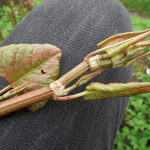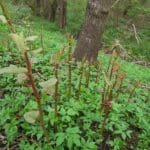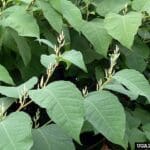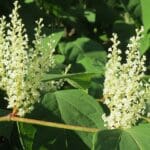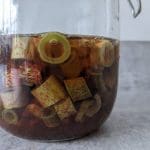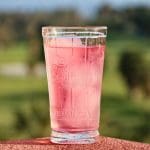Common Names
Japanese knotweed, Asian knotweed
Botanical Name
Fallopia japonica
Scientific Classification
Kingdom – Plantae
Order –Caryophyllales
Family – Polygonaceae
Physical Characteristics of Japanese Knotweed
Japanese knotweed is a hardy, herbaceous, rhizomatous perennial. Plants are fully dioecious, with all individuals of the UK clone being functionally female.
It is an incredibly invasive plant, but it has an amazing rhubarb flavour which we can use in cooking.
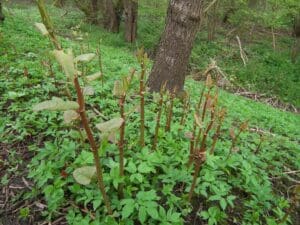
Why not check out our Knotweed foraging video?
Roots
Rhizomes measure up to 10cm in diameter, bearing nodes at 1-2cm spacing’s, and extend generally up to 7 metres from the parent plant (though distances of 20 metres have been recorded). The rhizome penetrates downward to a depth of 2 metres or more. They can damage the foundations of buildings and are very difficult to get rid of – there’s a reason why developers and homeowners hate to see it!
Stems
Stems can reach 3 metres high and are stout, hollow and bamboo-like with erect bases that eventually branch. Stems are sometimes red-brown, but often green and are smooth, with thinly membranous sheath.
Leaves
Leaves are wide at the base with the tips abruptly tapering to a point. The leaves measure 5-12cm wide and 5-15cm long, petioles 1-3cm long and stipules 8-15mm long.
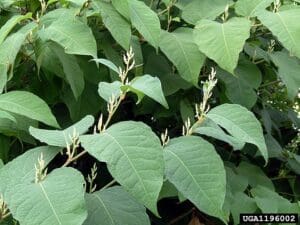
Flowers
The female flower is greenish-white and drooping. Flowers are 2.5-3mm across in dense, branched, auxiliary panicles, which are 5-9cm long.
Habitat
Throughout the entire UK and mainland Europe from Northern Italy to Norway.
Roadsides, railway banks, rivers, ‘waste’-ground, and similar areas, especially in urban and suburban landscapes.
Known Hazards
Oxalic acid and oxalates are mild nephrotoxic acids that are abundantly present in the stem and leaves of Japanese Knotweed (as well as such plants as fat hen, rhubarb and sorrel). They won’t cause an issue in regular amounts, but could cause a problem if eaten in large quantities.
The main thing to be wary of when picking this one is to be certain that someone hasn’t sprayed or injected it with pesticides. Always ask the local land owners.
Could be confused with
Giant Knotweed (Fallopia sachalinensis) or hybrids between the two species. However these are all similarly edible too.
Edible Use
Root: (Sept- March) Starch can be extracted (with caution) and used as a thickener like cornflour.
Stem: (April-May) Young tender stem tops can be eaten raw or cooked and used as a
rhubarb substitute for crumbles, pies, sorbets, sauces, pickling, and in both sweet and savoury dishes.
Flower Buds: (May-Aug) Can be used for wine, beer, tisane making.
Click here for our favourite Japanese Knotweed recipes.
Notes on Herbal uses
The roots of Japanese Knotweed are used to help treat Lyme’s Disease.
Extra notes from the Foragers
To ensure you pick only the tender stems gently bend back the stem from the top of the plant. Like asparagus, it should snap at the tender point leaving you with a piece between 2-20 cm long. Finally, it should be noted that it is illegal to cause the spread of this plant, and you really, really dont want it taking root on your property as it can cause thousands of pounds worth of damage. Therefore all off-cuts should be burnt, boiled or allowed to rot before composting – not thrown in the bin.



